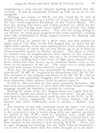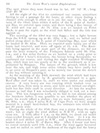Rae Reports First Signs of the Expedition (1852)
Communicated by the Hudson's Bay Company.
Read April 5, 1852.
To Archibald Barclay, Esq., Secretary to the Hudson's Bay Company.
Fort Simpson, 27th September, 1851.
SIR,— Having in my report, dated at the Kendall River on the 10th June, and addressed to Sir George Simpson, communicated the details and result of my spring journey over the ice and snow along the Arctic shores, I have now the honour to acquaint you that the boat expedition under my command, which visited the Polar Sea this summer, arrived here yesterday in safety, but I regret to say without having gained any information of Sir J. Franklin and party.
[...]
The morning of the 20th August being very fine and clear, land was seen in one or two directions in which it had not been previously noticed, and bearings were taken of it. The young ice did not thaw until 10h. a.m. ; after which, by great perseverance, we made very tolerable progress. Working all night, and some-times aided by the sails, at 7h. 15m. a.m., on the 21st, we landed on the W. shore of Stromness Bay, and after staying 2 hours again pushed on ; but the ice being lighter, and consequently more closely packed on the shore, we had greater difficulty in making headway, and were at last obliged to wait the rise of the tide at a point in Parker Bay.
Having remained here 3 hours, and had an interview with a party of Esquimaux, at 3h. 30m. p.m. we again commenced creeping along shore, and had proceeded but a short distance when a piece of pine-wood was picked up which excited much interest. In appearance it resembled the butt end of a small flag-staff, was 5 feet 9 inches in length, and round except 12 inches at the lower end, which was a square of 2¾ inches. It had a curious mark, resembling this (s c), apparently stamped on one side, and at 2 ½ feet distance from the step there was a bit of white line in the form of a loop nailed on it with two copper tacks. Both the line and the tacks bore the Government mark, the broad arrow being stamped on the latter, and the former having a red worsted thread running through it.
[Note: Discovery of pieces of wood on shore is probable evidence of Franklin's ships]
We had not advanced a 1/2 mile when another piece of wood was discovered lying in the water, but touching the beach. This was a piece of oak, 3 feet 8 inches long. The lower part, to the height of 1½ foot, was a square of 3½ inches. Half of the square, to the extent of 6 inches at the end, was cut off, apparently to fit into a clasp or band of iron, as there was a mark of 3 inches broad across it. The remaining part of the stanchion (as I suppose it to have been) had been formed in a turning-lathe, and was 3 inches in diameter.
As there may be some difference of opinion regarding the direction from which these pieces of wood came, it may not be out of place to express here my own opinion on the subject.
From the circumstance of the flood-tide coming from the northward, along the E. shore of Victoria Land, there can be no doubt but there is a water-channel dividing Victoria Land from North Somerset, and through this channel I believe these pieces of wood have been carried along with the immense quantities of ice that a long continuance of northerly and north-easterly winds, aided by the flood-tide, had driven southward. The ebb-tide not having power enough to carry it back again against the wind, the large bay immediately S. of Victoria Strait became perfectly filled with ice, even up to the S. shore of Victoria Land. Both pieces of wood appear to have come to shore about the same time, and they must have been carried in by the flood-tide that was at the time flowing on during the previous ebb ; for the simple reason, that although they were touching the beach they did not rest upon it.
The spot where they were found was in lat. 68' 52' N. ; long. 103° 20' W.
[...]
I have the honour to remain,
Sir, your most obedient servant,
John Rae.

















